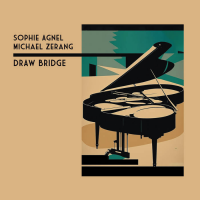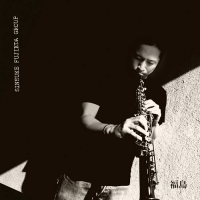Home » Jazz Articles » Album Review » Bongwool Lee: My Singing Fingers
Bongwool Lee: My Singing Fingers
On her debut recording, My Singing Fingers (Origin, 2018), Lee offers a unique blend of fragrant melodies, rich harmonies, and an instinctive sense of unpredictability that facilitates an approach to improvisation that presents images rooted in her eclectic and varied musical experience.
While piano trios inevitably have a leader's named assigned to them, they remain the ultimate expression of teamwork, of intimate conversational balance. Choosing musical partners then becomes the largest contribution a leader can make. In the case of Lee, her appropriation of bassist Luques Curtis, and drummer Kendrick Scott enables her to facilitate her artistic vision in a complete sense. Curtis, along with his brother, pianist Zaccai Curtis, has been a pivotal figure in recent modern jazz and latin circles through his own recordings with the Curtis Brothers, as well as such luminaries as pianists Orrin Evans and Eddie Palmieri. Scott has made his mark most prominently with two Grammy nominated recordings with trumpeter Terence Blanchard. Recent credits include the Charles Lloyd Quartet, with pianist Gerald Clayton. While these three fine musicians hail from very different circumstances, the creative give and take on this record is notable, even among the plethora of trio recordings that has saturated the jazz world since the dawn of piano trio classicism via the iconic works of Bud Powell and Bill Evans.
Though eight of the nine tunes on the album are Lee originals, perhaps it is her interpretation of the standard "Bye Bye Blackbird" that enables the listener to perceive commonalities of her approach to those of the masters that have come before her. While one might first allude to the piano trio version of the tune offered by the Keith Jarrett Standards Trio, it is the probing, exploratory sojourn into the tune by Miles Davis that may be more comparable to Lee's imaginative, visionary, and eminently singable solo work. The title track speaks to Lee's journey between European classical music and American jazz, both exemplified by her compositional strengths, and marvelous technical facility. Curtis' amazing ease in playing creates a relaxed, yet energetic feel that supports Lee's prodigious conceptual instincts. The fade out ending is a bit disappointing, the energy built to that point now suddenly sent adrift.
Lee's "How's Up There" is the climatic peak of the record. The piece features a Chopin-like melody, and a harmonic sense that creates ample space for melodic improvisation. The piano trio format is a study in the art of impermanence, immediacy being the prime directive on the journey. The spontaneous composition on this track provides evidence that the trio's creative process is operating at a high level. There is an undying willingness to be attentive, all in, and infuse the music with a relentless spirit of spontaneity. This piece projects a certain character, a certain soul, that in itself makes this album a worthwhile pursuit.
"Repeating Nightmares" proclaims something many who gravitate from the classical realm to jazz cannot-the ability to swing, to be connected to the blues tradition that is the absolute essence of the art form. There is a proclivity among classical musicians reaching out in the improvisational arts to venture towards the avant-garde, that this new found freedom must take total, unencumbered flight into new, previously undiscovered territory. Lee, it would seem, is not just another classical music freedom seeker, reaching out beyond the constraints of a finite form. Lee's passion for jazz music in itself redefines her musical character, and in a way, creates a new paradigm for musical expressionism existing between European, and American classical forms-the latter being the art of American jazz that has not only defied genre designation, but those designations defined by geographic location.
What is interesting is Lee's ability to express her musical journey compositionally, and to facilitate perfectly her musical stream of consciousness, with flawless technique. It is her actual sound that is stunning. One suspects her abandon to jazz moving forward will enrich that sound and provide a broader based palette from which to draw. While her past recognition as a young classical prodigy will always be on her resume, the aura surrounding her foray into the jazz realm suggests that Lee will continue to fit comfortably into the space of American eclecticism. As listeners, we need to only listen—really listen—and the rest, in a sense, will take care of itself.
Track Listing
My Singing Fingers; Sungshin Piano; How's Up There?; Bye Bye Blackbird; Repeating Nightmare; After The Black Dog; Feminite Du Bois; Why Not; Burning Incense.
Personnel
Bongwool Lee: piano; Luques Curtis: bass; Kendrick Scott: drums; Taylor Eigsti: Fender Rhodes (3).
Album information
Title: My Singing Fingers | Year Released: 2018 | Record Label: Origin Records
Tags
PREVIOUS / NEXT
Support All About Jazz
 All About Jazz has been a pillar of jazz since 1995, championing it as an art form and, more importantly, supporting the musicians who make it. Our enduring commitment has made "AAJ" one of the most culturally important websites of its kind, read by hundreds of thousands of fans, musicians and industry figures every month.
All About Jazz has been a pillar of jazz since 1995, championing it as an art form and, more importantly, supporting the musicians who make it. Our enduring commitment has made "AAJ" one of the most culturally important websites of its kind, read by hundreds of thousands of fans, musicians and industry figures every month.


















